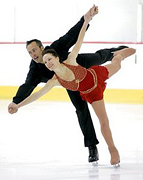We begin with a good warm-up (some days at 6 a.m., this is really more of a wake-up), then when we are ready, we begin executing each element from our program from easiest to most difficult. This warms up each move and prepares us for the run-through of our routine, which we skate with music once every day. If we miss anything during this run-through, we go back and do the entire section of the routine where the problem occurred until we do it right. Then, in any remaining time, we either work on one of our moves to make it better or we work on a brand new one. This focused and repetitive training regime has given us very good results in a short span of time, and also has caused us various physical problems for which we have needed to seek chiropractic help.
How did you first get involved with chiropractic?
William: My first experience with chiropractic was when I was 18. I had a persistent pain running down my left thigh for almost six months, which wasn't precipitated by any specific incident. Some days it would really bother me and some days I could manage it, but it was always there ... whatever it was. I went to see my family's medical practitioner whose advice I don't remember, but whatever it was, it didn't offer any relief. One day, my older brother told me about a chiropractor he went to see for some problem, mentioning how quickly his problem was eliminated. I went to see this chiropractor as soon as possible, and within a few adjustments over a couple of weeks, my leg pain had gone away.
How does chiropractic care improve your performance?
 Choeleen: There are so many ways! Skating is a very imbalanced sport in that we are required to land on the same leg repeatedly for jumps, spin again and again in one direction, etc. Falls also are a part of skating, especially when going from singles to pairs in a short period of time. Just one fall can really change your body alignment, not to mention the bruising and possible scar tissue buildup. Lastly, the intensity of our training took a toll on my body in the form of muscle strains and tendonitis. Some days my body felt so sore and out of balance that I wondered how it would be able to continue to function at such an intense level. Luckily, I knew our chiropractor, Dr. Dumbadse, would be able to address all that comes with intense training as an adult with successful results. In addition, she has always taken a holistic approach in giving care, including ideas for nutrition/supplements, psychology, and cutting-edge, sport-specific training methods. She is a wealth of information!
Choeleen: There are so many ways! Skating is a very imbalanced sport in that we are required to land on the same leg repeatedly for jumps, spin again and again in one direction, etc. Falls also are a part of skating, especially when going from singles to pairs in a short period of time. Just one fall can really change your body alignment, not to mention the bruising and possible scar tissue buildup. Lastly, the intensity of our training took a toll on my body in the form of muscle strains and tendonitis. Some days my body felt so sore and out of balance that I wondered how it would be able to continue to function at such an intense level. Luckily, I knew our chiropractor, Dr. Dumbadse, would be able to address all that comes with intense training as an adult with successful results. In addition, she has always taken a holistic approach in giving care, including ideas for nutrition/supplements, psychology, and cutting-edge, sport-specific training methods. She is a wealth of information!
How often do you visit your chiropractor?
Choeleen: In the weeks before the competition, I was visiting my chiropractor two or three days a week. Often, the group of adults training for the competition from our rink would race each other to Dr. Dumbadse's office after morning training time.
What is your health and wellness philosophy?
William: My philosophy on health and wellness is to maintain mental, emotional and physical balance. I work to accomplish this by continually trying to learn new things (taking classes and pursuing personal interests), having a spiritual practice (taking time for meditation and inner reflection), and exercising regularly (skating, weight training and yoga).
What exercise and nutrition recommendations do you have for people looking to improve their health and lifestyle?
Choeleen: Find several activities you enjoy. If you are having fun and doing a variety of activities, your chances of staying active are fairly high. As for nutrition, I am a vegetarian. I don't preach this type of eating, but I do promote eating organic, whole foods as much as possible, as well as drinking plenty of water. I also don't believe in denying yourself treats. I would live on chocolate, red wine and ice cream if I could - instead, I eat them in moderation.

